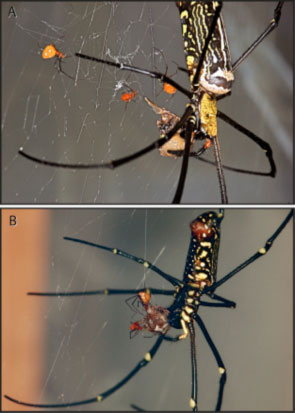本網站已搬家!
自 2014 年 3 月起,我們將網站遷移到新伺服器:http://web.ntnu.edu.tw/~treehopper/。本網頁內容已不再更新。請更新您的瀏覽器書籤亦或任何相關網址。
成員清單
目前成員
- 王若凡
- 1. 短腹幽蟌 Euphaea formosa 的領域行為. 2. 角蟬前胸背板的演化模式.
- 陳宏年
- 1. 颱風如何影響白痣珈蟌, Matrona cyanoptera 的存活率. 2. Euphaea amphicyana 表型變異模式.
- 葉人瑋
- 臺灣 Carabus 步行蟲生態與演化.
- 鄭筠潔
- 水蠆到底吃什麼?短腹幽蟌和白痣珈蟌稚蟲的DNA條碼食性分析.
- 黃崇鑫
- 雞冠細身鍬形蟲大顎對稱性與發育不穩定性.
- 曾惠芸
- 1. 球背象鼻蟲體色斑紋的功能. 2. 球背象鼻蟲親緣關係與體色斑紋的演化. 3. 蘭嶼與綠島球背象鼻蟲族群遺傳研究.
- 蕭伊廷
- Euphaea amphicyana 幽蟌生殖器變異.
- 陳彥廷
- 大雪山森林經營模式對鞍馬山步行蟲型態的影響.
- 黃均蕙
- 鹿角鍬形蟲的打鬥行為模式.
- 吳詩婷
- 角蟬.
- 林橋威
- 鹿角鍬形蟲的打鬥行為模式.
- 蘇詠超
歷屆成員
- 蕭瑋良
- Euphaea amphicyana 幽蟌翅脈地理變異.
- 翁麗紋
- 黃緣螢幼蟲為何發光?
- 李逸鴻
- Euphaea 屬豆娘種化模式.
- 關哲昀
- 雞冠細身鍬形蟲大顎變異.
- 鄭竹晏
- 菲律賓弧角蟬親緣地理.
- 陳明玉
- 菲律賓雅角蟬 Centrochares horifficus 的親緣地理與族群歷史.
- 黃紹彰
- 白痣珈蟌視覺溝通系統
- 黃仁磐
- 短腹幽蟌 Euphaea formosa 的族群遺傳與親緣地理分析
- 陳薇云
- 泡沫蟬 Okiscarta uchidae 內共生菌之分子特徵與親緣關係
訪問學者和學生
- Vanitha Williams
- 負子椿象和蜻蜓幼蟲對孓孓的補食潛力
- Marina Vilenica
- 克羅埃西亞 Turopolje 地區溼地蜻蜓組成
- Klaas-Douwe 'KD' B. Dijkstra
- 蜻蛉歷史,多樣性,與鑑定
- Erin McCullough
- 武器的多樣性: 甲蟲的空氣動力損耗.
- Ashley E. King
- 獨角仙之性別內打鬥與性別間敵對行為.
蘇詠超

職稱
博士後研究員 2012
研究物種:Argyrodes miniaceus, A. miniaceus are stealing food from their host, Nephila pilipes, cooperatively.

研究主題
行為生態、社會生物、族群遺傳、及分子親緣關係
摘要
電子郵件:ycsu527@gmail.com
Education
Ph.D. in Ecology and Evolutionary Biology, University of Kansas, USA
M.S. in Biology, Tunghai University, Taiwan
B.S. in Biology, Tunghai University, Taiwan.
Research summary
My dissertation was about the group-living behavior in kleptoparasitic Argyrodinae (Araneae: Theridiidae), and the species level molecular phylogenetic analysis of the Argyrodinae. I included four research approaches in this dissertation. I showed the first empirical study of cooperative kleptoparasitism in Argyrodinae. The results showed that, at least at the level of foraging, group-living behavior has adaptive function of cooperation. Using a game theory model, the payoff of being cooperator in a group is greater than the payoff of being solitary. Second, I found that kleptoparasites do not aggregate simply because the webs are large and can support multiple kleptoparasites. Social interactions among group members provide additional benefits that favor individuals remaining in groups. In the population genetic studies, I discovered that group members could gain indirect benefit of fitness by cooperating with group members, who are potentially related individuals. This is because in group-living Argyrodes, group members are significantly more closely related than the individuals drawn randomly from the population in a small geographic scale. The phylogenetic analyses showed several independent origins of group-living behavior in different species groups. The evolutionary sequence of foraging strategies of Argyrodinae is from free-living to araneophagy, then to kleptoparasitism. The comparative analyses showed the specialization to large host is correlated with the evolution of group-living behavior. In addition, the processes of specialization thus becoming group-living may have caused diversification within species groups.
The main project for my postdoc position in Dr. Lin’s lab is to develop methods for several phylogeographic projects for treehoppers and damselflies in SE Asia using both Sanger sequencing data and next generation sequencing data.
Publication
Su , Y. C., Chang, Y. H, Smith, D. R., Zhu, M. S., Kuntner, M., and Tso, I. M. 2011. Biogeography and speciation patterns of the golden orb spider genus Nephila (Araneae: Nephilidae) in Asia. Zoological Science 28(1): 47-55.
Cobbold, S. M., Su, Y. C. 2010. The host becomes dinner: possible use of Cyclosa as a nuptial gift by Argyrodes in a colonial web. Journal of Arachnology 38:132-134.
Su, Y. C., Chang, Y. H., Lee, S. C. and Tso, I. M. 2007. Phylogeography of the giant wood spider (Nephila pilipes, Araneae) from Asian–Australian regions. Journal of Biogeography 34: 177-191.
Lee, J. W., Jiang, L., Su, Y. C. and Tso, I. M. 2004. Is Central Mountain Ridge a geographic barrier to giant wood spider Nephila pilipes (Araneae, Tetragnathidae) in Taiwan? A population genetic approach. Zoological Studies 43(1): 112-122.